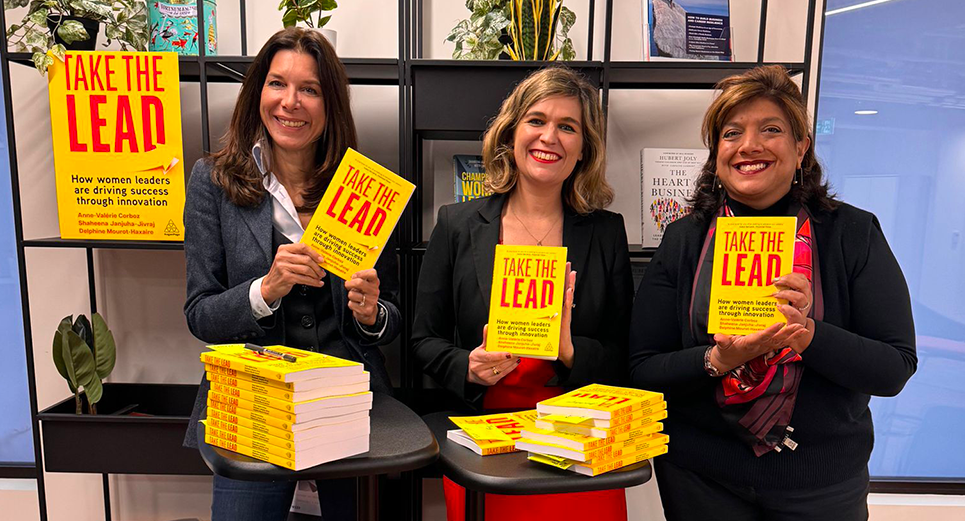Sailing the Seven C's Towards Women Leadership Roles
How can business close the prevailing gender gap for leadership positions? Three top HEC academics discuss ways to increase the number of women leaders in their groundbreaking publication “Take the Lead”. Through their fieldwork involving around 1,000 women they offer practical strategies and inspiration to boost leadership skills and drive influential changemakers. Through the book’s practical advice and exercises, they aim to accelerate women representation which currently stands at 26% of business leaders.

Thumbing through “Take the Lead: How women leaders are driving success through innovation”, one can only be struck by the diversity of experiences, the lucidity of approach and the true grit of the women leaders described in these 217 pages. Professors Shaheena Janjuha-Jivraj, Anne-Valérie Corboz and Delphine Mourot-Haxaire have combined their decades of experience to produce an in-depth guide for women to overcome the dogged challenges to gender parity amongst leaders. “We wanted to challenge the ideas behind how women pursue their careers,” they write from the get-go. “There is a need to revisit the tools for women and reposition what women need and take with them, irrespective of where they work and live.” The need has become all the more urgent when one reads the latest statistics published by The Women’s Forum Barometer: 47% of women in the under-35 generation believe that the female brain is different from the male brain leading to different ability to work on sciences. A further 36% consider the salary gap unimportant. “Fighting stereotypes from a young age,” the barometer report continues, “is key.”
This was one of several points made by the co-authors at the official book launch at the HEC UK House in London on February 7. In front of a packed audience at the center, the three academics shared the fruits of their labor, which took an intense six months to write: “The launch was a great opportunity to say thank you to the women contributors in the book,” notes Janjuha-Jivraj, “and also to pause and think about what still needs to be achieved. In 2023, the World Economic Forum declared that it would take 131 years to achieve gender parity worldwide – that’s five generations! There was quite a gasp in the room when we talked about this. The aim of the book is to use the innovation and creativity lens here, so diversity is seen as crucial for business success."
Sailing to Gender Parity Island
Creativity was something of the operative word when it came to drafting the book. The three scholars decided to use nautical imagery to describe the voyage that women, including themselves, embarked on to make their careers progress to the top: “We really enjoyed ourselves with the sailing analogy!” says Mourot-Haxaire, who also runs the HEC UK House. “The canvas could have been ‘simple boxes’ , and we thought the boat brings not only a creative touch, but indeed an ocean of potential metaphors.”
That literary voyage sometimes felt like the odyssey Ulysses embarked on in Greek mythology: “Working in the field of women’s leadership is like navigating a boat on a long journey,” the authors write in the introduction. “We interviewed inspiring women, who had an international career and had faced transitions and challenges,” adds Corboz. “They were from different sectors, continents, backgrounds, and we were very keen to have this diversity of voices in the book. For a more quantitative perspective, we launched a survey of 1,000 women.”
Navigating the Seven Cs with Three Pairs of Hands on Deck
The three scholars built their book around seven Cs: Creativity, Compass, Courage, Connection, Champions, Curating teams and Careers. Sharing the tasks was something of an ingenious and intuitive experience: “We never sat in the same room while writing,” continues Corboz. “Our work was based on ‘layers’ or ‘sedimentation’. We had the canvas and added layers for each C, each chapter. After the first draft, we tagged on the results of our survey, the latest pieces of research, and the quotes from the inspiring women we met for the project. In a way, we all worked on each chapter simultaneously, so our voices could be blended in each chapter, and this was a very iterative process.”
The women leaders the co-authors met shared powerful insights on the challenges they have faced in reaching the top. “There’s often too much humility from women,” Cécile Hillary, a senior banker in London, tells them in one of the interviews. “Almost as if women need to apologize for the opportunities they’re getting.” Delphine Inesta delves on the courage she has needed in her work as a partner in a turnaround fund in France: “I work in a field that is quite hard. It's about turning around small companies that face difficulties. So, courage is really central. It is the courage of being able to tackle issues and to take a stance and positions that are not necessarily well received by the community at the beginning. I have noticed that women often address issues in a more direct way. They do not embarrass themselves with too much politics.” But it sometimes takes courage even to say “no”. The co-authors talk to Nadia Verjee, Executive Director at the Expo Dubai Group : “I rarely have said no to my boss,” she tells them. “Have I done it at times at my own expense? Yes, I have. Have I done it in circumstances where it has eaten into my life considerably? Yes – is it because we have massive deliverables to deliver, and we have to get on with it? Now that the mega event is over, I can say, “let’s think about this.” The writers quote Rice University’s Katharine O’Brien: “(O’Brien) examined what happens when women say no professionally. Her starting point demonstrated that women say no far less often than men in the workplace.”
Below C Level, Resistance to Gender Equality
O’Brien is one of a plethora of academics who have explored the aspirations of women and the challenges in reaching leadership roles. This is testified by the five-page bibliography the trio of scholars publish at the end of “Take the Lead”. You can add to that Joanne Lipman’s That’s What She Said: What Men Need to Know (and Women Need to Tell Them) About Working Together and Women and Leadership: Real Lives, Real Lessons by Julia Gillard and Ngozi Okonjo-Iweala. But the approach of the HEC academics brings in the vital role of innovation and creativity in affirming women leadership roles: “What makes this book different is the sediments,” says Janjuha-Jivraj, “the layers of having testimonies from inspiring women, practical tips for the reader, and detailed points on recent research.” The co-authors also pinpoint the value of gender diversity in leadership as a way of suggesting innovative solutions for the complex problems business outlets face. They draw on examples on all five continents, underlining the universality of the successes and challenges. This is corroborated by research elsewhere, such as the work by HEC professor Oliver Gottschalg on private equity deals led by female investment managers.
Yet, resistance to gender equality amongst leaders persists: “There is no magic wand or formula to address this, admits Corboz. “There are both institutional and individual barriers. The canvas we have created is a tool to map areas of improvement at an individual level, as women cannot wait to the institutional barriers to be dismantled.” Mourot-Haxaire adds: “Providing innovative solutions for the complex problems we face is also about being able to hear the diverse voices around the table, as gender diversity is crucial to ensure decisions are made with the broadest perspective of stakeholders. Being around the table, being heard and bringing a diverse opinion requires trust around that table, and a safe space for women to be able to express their opinion, and avoid group think.”
The HEC academics don’t confine their reflections to research and theory. The books suggests practical exercises and role-play for each of the seven Cs, to make the gender leadership challenge evolve. They range from Stretch roles to practical ways of pivoting women’s mindset: “We hope our readers will find the time to reflect, and connect the dots, with hindsight,” says Janjuha-Jivraj, who was recently lauded by Inc. Media as an icon of excellence in diversity and entrepreneurial leadership. “Maybe some will realize they were creative when they solved a problem, while maybe not thinking they were at the time, and then gain the confidence to stretch their skills and go for their next stretch assignment.” Corboz, meanwhile, insists on the links between the exercises in the book and the ones at HEC where she is Associate Dean for Executive Education: “Our programs are always very experiential, the idea is to take our participants outside of their comfort zone, so they can feel a stretch, and gain the confidence to explore new territories, new ways of thinking and innovating.”
At the same time, the three academics will continue to sail the gender seas to navigate the currents between men and women leadership: “Unfortunately, the gap is not about to disappear, so there is so much more work to do on this issue!” admits Mourot-Haxaire. “There will be other Cs to explore. As of now, we are delighted to bring the canvas to our readers and hope they will enjoy the invitation to embark on a ‘voyage’ with us, and maybe join ‘onboard’ our HEC women leadership programs!”
For further information on “Take the Lead” and HEC’s Women Leadership Program, please read Carmina Marcarian’s interview of the three co-authors.

